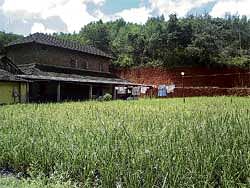
Not too long ago, Dakshina Kannada district was known as the treasure-house of paddy. Today though, things have changed. Paddy fields are slowly disappearing. In their place are areca plantations. A situation has arrived where farmers have had to buy rice. Along with the disappearance of paddy fields, an entire way of life too seems to be on its way out...a way of life revolving around agricultural activities such as the tradition of Hosa Akki Oota (a meal cooked with freshly harvested paddy).
Areca growers of the region typically have a huge area in front of their homes to dry areca. With their areca farms occupying a vast stretch, the courtyard in front of the homes gets bigger too. The areca growers constantly struggle to ensure that this area is not affected during rain.
This they do, by using areca fronds or coconut fronds to cover the area. In the recent past, there has been a new development. That of farmers trying to grow paddy in this courtyard in front of the house. One such farmer who has successfully grown paddy in his yard is Puttur’s Banari Eshwar Prasad.
‘Cannot be used for cultivation’
“The area where areca is dried should be maintained well. One cannot dig up the land or use it to cultivate any other crop,” explains Eshwar Prasad. It was last June when Eshwar hit upon the idea of growing paddy in the courtyard. When the first rain of the season came down, this areca grower spread areca peel on 20 cents of land. When the second spell of rain came down, he sowed paddy seeds at an interval of one foot. The paddy seeds were sown on the areca peel.
To do so, he took a five-foot-long PVC pipe, and tied a plastic jug to one end of it. He filled paddy seeds into the jug. Towards the other end of jug, he attached an eight-inch stick. Each time he had to sow, Eshwar counted five seeds from the jug and put it into the PVC pipe. Every eight inches, he sowed paddy seeds.
“Because there is a possibility of ants and birds getting to the paddy seeds, I sow very few of them at one time,” explains Eshwar, who sowed the basmati strain of paddy on this plot. Also, because there is the danger of seeds getting washed away when there is heavy rain, it is ideal to sow paddy during the first rain, he explains.
Within a week, the seeds start to sprout. There is no chance of digging up the soil and planting paddy at all on this space, he adds. Fifteen days after sowing paddy, he ensured that the right fertilisers were used on the plants. He also took care to see that there were no pest attacks by spraying a mixture of garlic juice and asafoetida on the crop. Within four months, the paddy was up for harvest. The yield was a good one-and-a-quarter quintals of paddy.
A strain other than basmati
“The yield from basmati is low. It is also more susceptible to pest attacks. Because the roots are not allowed to touch the soil, there are chances of the paddy falling off sideways when it grows too tall. I hope to sow another strain of paddy next year; the gidda (the short -grained ) variety,” explains Eshwar. “Also, because there are no paddy fields in the surrounding areas, all the birds flock to my fields.
Nevertheless, it brings great joy to see the vast field of green. Because there is not much of an investment when it comes to raising the crop, any profit is good enough,” he points out.
Because it rains constantly between June and October in the coastal areas, there is not much of a water problem in the region. Areca peel has the ability to soak in the water, and the crop is not affected even if it doesn’t rain for three or four days, the farmer explains. One can grow this crop in the organic method and harvest a decent paddy crop for domestic use, he points out.